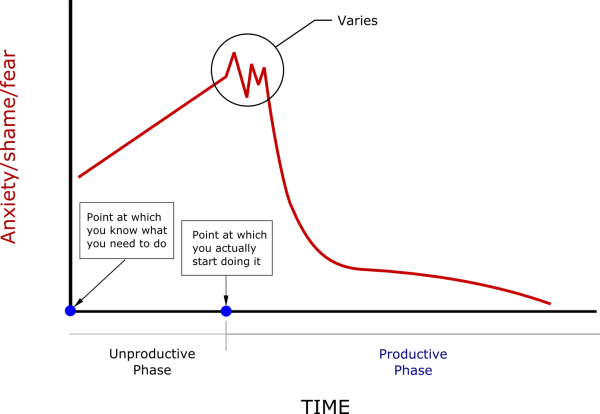Building Discipline and Overcoming Procrastination
Episode #6 of the course How to boost your studying and test-taking skills by Valeria Shvediuk
Welcome back!
Today, we’ll talk about discipline and conquering procrastination, which form the bedrock of good studying habits and skills.
Self-discipline, or the ability to act in your best long-term interests, is decisive when it comes to successful test preparation:
• Focus: One hour of high-quality, deep concentration on one problem will take you much further than a day of juggling multiple tasks at once [1]. When you multitask, you train your brain to constantly switch over to distractors. Teach yourself to focus on what’s important by ignoring distractors or eliminating them (using ColdTurkey, FocusMe, or Freedom).
• Consistency: Small gains add up over time; the complex neural circuitry for your new skill or knowledge needs time and repetition to develop. Commit yourself to studying every day, even just a little.
• Time management: If you never have enough time, then you either have no priorities or you’re dealing with a famous time thief, procrastination. This is an intimately familiar struggle for most students. Let’s investigate it more deeply.
Your Arsenal against Procrastination
We put off doing things that we expect will be difficult, boring, uncertain, or prone to failure. Instead, we choose less important and often entertaining activities—that’s why even the usual chores become more exciting than the dreaded statistics project. As such, the essence of procrastination is two-fold: a fear of future work and often, an instantly gratifying activity that replaces this work. As the deadline looms, we also feel guilty and anxious. These emotions, fueling procrastination, are controlled by the limbic system (the “lizard brain”), which is responsible for fear and pleasure. When we finally get down to work, executive functions such as planning and logical thinking (controlled by our prefrontal cortex, which we only share with mammals) take over and replace those negative emotions. Since the mental processes before and after you start working are driven by completely different neural mechanisms, the pain and scruples you have while procrastinating dissipate as soon as you start acting [2]!

Image copyright (c) 2019 David Cain [3], used with permission
The key to conquering procrastination is to set ourselves to action as quickly as possible—continuing the momentum will be easier once we get going. Below are tactics of accomplishing just that. Defeating procrastination is a highly personal matter, so try various techniques to find which one works best for you.
• Start work on the task you’ve been postponing first thing in the morning. This technique is known as eating the frog [4], i.e., doing the most unpleasant task of the day first, when your energy and willpower are at their peak.
• For shorter tasks, overcome inertia with the five-second rule [5]. Simply count down backward from 5 to 1, and on 1, you do what you must do. This trick works by preventing your mind from coming up with excuses and instead, redirecting you into action.
• For longer tasks, use the Pomodoro technique. Set a timer and work uninterruptedly for exactly 25 minutes, after which you take a 5-minute break. You then repeat the cycle. During the 25-minute period, you can’t do anything other than working on your task or staring at a blank page or screen. Even if you’re blocked, you’ll get bored quickly and eventually start working.
• Decide to simply work on a task for a period of time without the intention to complete it during this time (process over outcome).
• Create a ritual that gets you into the zone. For me, it’s cleaning my desk, setting my devices to flight mode, and putting my headphones on—I’m then ready to crack on!
• Tell a friend about your task, and hold yourself accountable to them about your progress. You may even agree to pay them $5 if you fail to complete it on time.
• Keep a work progress journal where you either tick off a finished task or write down a reason it wasn’t completed. You’ll soon see where your time really goes (also, use RescueTime for this).
Daily task: Combine the five-second rule and the Pomodoro technique to start working on a task you’ve been postponing.
See you tomorrow, when we’ll be talking about an unfailing test preparation technique.
Valeria
Recommended book
Atomic Habits: An Easy and Proven Way to Build Good Habits and Break Bad Ones by James Clear
Recommended reading
Why Procrastinators Procrastinate by Tim Urban
Recommended video
Pomodoro Technique Explained: How to Stay Focused Using the Pomodoro Technique
References
[1] Multitasking: Switching Costs
[2] Procrastination: A Scientific Guide on How to Stop Procrastinating
[3] How to Get Yourself to Do Things
[4] Eat That Frog!: 21 Great Ways to Stop Procrastinating and Get More Done in Less Time by Brian Tracy
Share with friends

